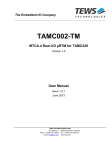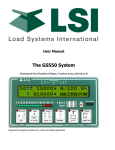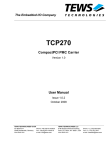Download TAMC260 - powerbridge.de
Transcript
The Embedded I/O Company TAMC260 PMC-Carrier for AMC User Manual Issue 1.0.4 September 2012 TEWS TECHNOLOGIES GmbH Am Bahnhof 7 25469 Halstenbek, Germany Phone: +49 (0) 4101 4058 0 Fax: +49 (0) 4101 4058 19 e-mail: [email protected] www.tews.com TAMC260-10R Full-Size PMC-Carrier for AMC, 5V PMC I/O Signaling Voltage TAMC260-11R Full-Size PMC-Carrier for AMC, 3.3V PMC I/O Signaling Voltage TAMC260-20R Mid-Size PMC-Carrier for AMC, 5V PMC I/O Signaling Voltage TAMC260-21R Mid-Size PMC-Carrier for AMC, 3.3V PMC I/O Signaling Voltage This document contains information, which is proprietary to TEWS TECHNOLOGIES GmbH. Any reproduction without written permission is forbidden. TEWS TECHNOLOGIES GmbH has made any effort to ensure that this manual is accurate and complete. However TEWS TECHNOLOGIES GmbH reserves the right to change the product described in this document at any time without notice. TEWS TECHNOLOGIES GmbH is not liable for any damage arising out of the application or use of the device described herein. Style Conventions Hexadecimal characters are specified with prefix 0x, i.e. 0x029E (that means hexadecimal value 029E). For signals on hardware products, an ‚Active Low’ is represented by the signal name with # following, i.e. IP_RESET#. Access terms are described as: W Write Only R Read Only R/W Read/Write R/C Read/Clear R/S Read/Set ©2012 by TEWS TECHNOLOGIES GmbH All trademarks mentioned are property of their respective owners. TAMC260 User Manual Issue 1.0.4 Page 2 of 25 Issue Description Date 1.0.0 Initial Issue May 2009 1.0.1 New Board Revision, added „Handling and Operation Instructions” July 2009 1.0.2 Added -2x Variants (Mid-Size Front Panel) added “TAMC260 Mid-Size Option Usage Restrictions” added “8.4 Component Height Violation on TAMC260-2x” November 2011 1.0.3 Only available in RoHS-compliant version December 2011 1.0.4 Expanded Table 7-1 to cover PMC suitability added “FRU Data Multi Records” September 2012 TAMC260 User Manual Issue 1.0.4 Page 3 of 25 Table of Contents 1 2 3 PRODUCT DESCRIPTION ......................................................................................... 6 TECHNICAL SPECIFICATION................................................................................... 7 HANDLING AND OPERATION INSTRUCTIONS ...................................................... 8 3.1 3.2 3.3 3.4 4 ESD Protection ................................................................................................................................8 PCI Bus Signaling Voltage .............................................................................................................8 Voltage Limits on PMCs .................................................................................................................8 TAMC260 Mid-Size Option Usage Restrictions............................................................................8 PEX8112 TARGET CHIP............................................................................................ 9 4.1 PCI Express Configuration Space Register Mapping .................................................................9 4.1.1 PCI-Compatible Configuration Registers (Type 1) ..............................................................9 4.1.2 PCI-Compatible Capability Registers.................................................................................10 4.2 PCI Bus Device Number Mapping ...............................................................................................11 4.3 PCI Clock .......................................................................................................................................11 5 CONFIGURATION HINTS ........................................................................................ 11 5.1 PEX8112Configuration EEPROM.................................................................................................11 6 MODULE MANAGEMENT ....................................................................................... 12 6.1 Indicators .......................................................................................................................................12 6.1.1 On Board Link-LED ............................................................................................................12 6.1.2 Front Panel LEDs...............................................................................................................12 6.2 Temperature and Voltage Sensors..............................................................................................12 6.3 FRU Data Multi-Records ...............................................................................................................13 6.3.1 Connectivity Record ...........................................................................................................13 6.3.2 Module Current Requirement Record ................................................................................13 6.3.3 Clock Configuration Record ...............................................................................................13 7 PMC TO PCI INTERFACE........................................................................................ 14 7.1 PCI Signaling Voltage ...................................................................................................................14 7.1.1 PCI Bus Signal Voltage Level ............................................................................................15 7.1.2 PCI Signaling Levels and Voltage Keying..........................................................................15 8 INSTALLATION........................................................................................................ 17 8.1 AMC Module Insertion & Hot-Swap.............................................................................................17 8.1.1 Insertion .............................................................................................................................17 8.1.2 Extraction ...........................................................................................................................17 8.2 Installation of a PMC Module .......................................................................................................17 8.3 Voltage Limits on PMC Modules .................................................................................................18 8.4 Component Height Violation on TAMC260-2x ...........................................................................19 9 PIN ASSIGNMENT ................................................................................................... 20 9.1 9.2 9.3 9.4 9.5 Overview ........................................................................................................................................20 PMC J11 / P11................................................................................................................................21 PMC J12 / P12 and J22 / P22........................................................................................................22 PMC J14 / P14................................................................................................................................23 Front Panel I/O Connector X1 ......................................................................................................24 TAMC260 User Manual Issue 1.0.4 Page 4 of 25 List of Figures FIGURE 1-1 : BLOCK DIAGRAM.......................................................................................................................6 FIGURE 7-1 : PCI SIGNAL VOLTAGE CONFIGURATION RESISTORS (BOTTOM VIEW) ..........................15 FIGURE 7-2 : PMC VOLTAGE KEYING ..........................................................................................................16 FIGURE 8-1 : INSTALLATION OF A PMC MODULE ......................................................................................18 FIGURE 8-2 : COMPONENT HEIGHT VIOLATION ACCORDING TO AMC.0 ...............................................19 FIGURE 8-3 : COMPONENT HEIGHT VIOLATION ACCORDING TO MTCA.4.............................................19 FIGURE 9-1 : CONNECTOR OVERVIEW .......................................................................................................20 FIGURE 9-2 : FRONT PANEL I/O CONNECTOR NUMBERING ....................................................................24 List of Tables TABLE 2-1 : TECHNICAL SPECIFICATION......................................................................................................7 TABLE 4-1 : PCI-COMPATIBLE CONFIGURATION REGISTERS (TYPE 1) ...................................................9 TABLE 4-2 : PCI-COMPATIBLE CAPABILITY REGISTERS...........................................................................10 TABLE 4-3 : PCI BUS DEVICE NUMBER MAPPING......................................................................................11 TABLE 6-1 : ON BOARD LINK-LED ................................................................................................................12 TABLE 6-2 : FRONT PANEL LEDS .................................................................................................................12 TABLE 6-3 : TEMPERATURE AND VOLTAGE SENSORS ............................................................................12 TABLE 7-1 : TAMC260 PCI SIGNALING VOLTAGE FACTORY DEFAULTS.................................................14 TABLE 7-2 : PCI SIGNAL VOLTAGE CONFIGURATION RESISTORS MATRIX...........................................15 TABLE 7-3 : PCI SIGNAL VOLTAGE CONFIGURATION MATRIX.................................................................16 TABLE 8-1 : AMC MODULE INSERTION........................................................................................................17 TABLE 8-2 : AMC MODULE EXTRACTION ....................................................................................................17 TABLE 8-3 : VOLTAGE LIMITS .......................................................................................................................18 TABLE 9-1 : PMC J11/P11 AND J21/P21 PIN ASSIGNMENT........................................................................21 TABLE 9-2 : PMC J12/P12 AND J22/P22 PIN ASSIGNMENT........................................................................22 TABLE 9-3 : PMC J14/P14 PIN ASSIGNMENT...............................................................................................23 TABLE 9-4 : X1 PIN ASSIGNMENT.................................................................................................................25 TAMC260 User Manual Issue 1.0.4 Page 5 of 25 1 Product Description The TAMC260 is a standard double-width, Full- or Mid-Size AMC module that provides one slot for a single-width PMC module used to build modular, flexible and cost effective I/O solutions for all kinds of applications like process control, medical systems, telecommunication and traffic control. 32 bit PCI accesses are supported on PCI bus with PCI frequency 33 MHz and also 66 MHz. The PLX8112 PCIe-to-PCI bridge provides the real connection between primary PCIe link and the PMC slot. The bridge controls all PCI accesses and the frequency for the PMC access. The TAMC260 supports front panel I/O, alternatively a HD68 SCSI-V type connector provides access to the PMC P14 back I/O lines. The TAMC260 is a versatile solution to upgrade well known legacy I/O solutions to a high performance form factor. According to AMC.0, the TAMC260 provides an IPMI compliant Module Management Controller (MMC) with temperature monitoring and hot-swap support. MMC IPMB PCI Express to PCI Bridge PCIe (x1) J14 J11 32 bit 66 MHz AMC Connector PCI Bus J12 68 Pin Connector Power Supply Figure 1-1 : Block Diagram TAMC260 User Manual Issue 1.0.4 Page 6 of 25 2 Technical Specification AMC Interface Mechanical Interface Advanced Mezzanine Card (AMC) Interface confirming to PICMG® AMC.0 R2.0 -1x: Double-width / Full-Size Module -2x: Double-width / Mid-Size Module Electrical Interface PICMG® AMC.1 R1.0 PCIe single lane (x1) port (AMC.1 Type 1 compliant) IPMI IPMI Version 1.5 Front Panel LEDs Blue Hot-Swap LED Red Failure Indication LED (LED1) Green Board OK / PMC Activity LED (LED 2) On Board Devices PEX8112 (PLX Technology) PCI Express to PCI Bridge PMC Interface Number of PMC Slots 1 Supported PMC Data Width 32 bit Supported PCI Clock Frequency 33 MHz / 66 MHz PCI I/O Signaling Voltage 5V & 3.3V PMC I/O Access Front Panel I/O P14 Back I/O via front panel connector Physical Data Power Requirements 100 mA typical @ +12V DC (Payload Power) 30 mA typical @ +3.3V DC (Management Power) Additional power is required by PMC modules Maximum Power for PMC Modules 2 A typical @ +5V DC 2 A typical @ +3.3V DC 200 mA typical @ +12V DC 200 mA typical @ -12V DC Temperature Range Operating Storage MTBF 570 000 h -40°C - +85°C -40°C - +85°C MTBF values shown are based on calculation according to MIL-HDBK-217F and MIL-HDBK-217F Notice 2; Environment: GB 20°C. The MTBF calculation is based on component FIT rates provided by the component suppliers. If FIT rates are not available, MIL-HDBK-217F and MIL-HDBK-217F Notice 2 formulas are used for FIT rate calculation. Humidity 5 – 95 % non-condensing Weight 165 g Table 2-1 : Technical Specification TAMC260 User Manual Issue 1.0.4 Page 7 of 25 3 Handling and Operation Instructions 3.1 ESD Protection The TAMC260 is sensitive to static electricity. Packing, unpacking and all other handling of the TAMC260 has to be done in an ESD/EOS protected Area. 3.2 PCI Bus Signaling Voltage Be sure that the TAMC260 PCI bus Signal Voltage configuration matches the TAMC260 PMC slots keying pin configuration. If PMC modules are plugged into a PCI environment where the PCI signaling voltage does not match, damage to the equipment could occur, voiding product warranties. Refer to the chapter “PCI Signaling Voltage” for details. 3.3 Voltage Limits on PMCs The AMC.0 specification limits the voltages on AMC modules. These limits also apply to mounted PMCs. Refer to the chapter “Voltage Limits on PMC Modules” for details. 3.4 TAMC260 Mid-Size Option Usage Restrictions Please note that the Mid-Size module has restrictions to its usage because of a component height violation. It is within the responsibility of the user to carefully check if the Mid-Size module with its component height violation can be used in his system. Otherwise damage of the TAMC260 or its slot to be used in may occur! Refer to the chapter “Component Height Violation on TAMC260-2x” for details. TAMC260 User Manual Issue 1.0.4 Page 8 of 25 4 PEX8112 Target Chip The PLX8112 PCIe-to-PCI bridge provides the real connection between primary PCIe link and the PMC slot. The bridge controls all PCI accesses and the frequency for the PMC access. 4.1 PCI Express Configuration Space Register Mapping 4.1.1 PCI-Compatible Configuration Registers (Type 1) PCI CFG Register Address 31 24 23 16 15 8 7 0 0x00 PCI Device ID PCI Vendor ID 0x04 PCI Status PCI Command 0x08 0x0C PCI Class Code PCI Built-In SelfTest (Not Supported) PCI Header Type 0x10 10B5 8112 0010 0000 PCI Device Revision ID 060400 AA PCI Cache Line Size 00 01 00 00 PCI Base Address 0 0x14 0x18 Internal PCI Bus Latency Timer 0000000C PCI Base Address 1 Secondary Latency Timer Subordinate Bus Number Read after initialization write access 00000000 Secondary Bus Number Primary Bus Number 00 00 00 00 I/O Limit I/O Base 0220 00 00 0x1C Secondary Status 0x20 Memory Limit Memory Base 0000 0000 0x24 Prefetchable Memory Limit Prefetchable Memory Base 0000 0000 0x28 Prefetchable Memory Base Upper 32 Bits 0x2C 0x30 Prefetchable Memory Limit Upper 32 Bits I/O Limit Upper 16 Bits 0x34 0x38 0x3C 00000000 00000000 I/O Base Upper 16 Bits Reserved 0000 0000 PCI Capabilities Pointer 000000 40 Internal PCI Interrupt Line 0000 01 00 PCI Base Address for Expansion ROM (Not Supported) Bridge Control Internal PCI Interrupt Wire Table 4-1 : PCI-Compatible Configuration Registers (Type 1) TAMC260 User Manual Issue 1.0.4 Page 9 of 25 4.1.2 PCI-Compatible Capability Registers PCI CFG Register Address 0x40 0x44 31 24 23 16 Power Management Capabilities Power Management Data 15 8 Power Management Next Capability Pointer Power Management Bridge Support 0x48 Device-Specific Control Reserved Message Signaled Interrupts Control 0x54 0x58 6A02 5001 00 00 0000 0000 0000 0000 0000 Message Signaled Interrupts Next Capability Pointer Message Signaled Interrupts Capability ID 0080 60 05 0000 0000 Message Signaled Interrupts Upper Address 0000 0000 Reserved 0x60 PCI Express Capabilities Message Signaled Interrupts Data 0x64 PCI Express Next Capability Pointer PCI Express Capability ID Device Capabilities PCI Express Device Status 0x6C 0x70 Power Management Capability ID Read after initialization write access Message Signaled Interrupts Address 0x5C 0x68 0 Power Management Control/Status 0x4C 0x50 7 0071 00 10 0000 0000 PCI Express Device Control Link Capabilities Link Status 0x74 0000 0000 0000 2000 0002 4C11 Link Control Slot Capabilities 0011 0000 0000 0C80 0x78 Slot Status Slot Control 0x7C Reserved Root Control 0400 0000 0000 0000 0x80 Root Status 0000 0000 0x84 Main Control Register Index 0000 0000 0x88 Main Control Register Data 0000 0000 Table 4-2 : PCI-Compatible Capability Registers TAMC260 User Manual Issue 1.0.4 Page 10 of 25 4.2 PCI Bus Device Number Mapping The PCI bus device number of the PMC slot is defined by configuration type translation of the PEX8112 PCI-Express to PCI Bridge. By default PMC slot 1 is mapped to bus device number 0x04. PCI Bus Device Number (HEX) PCI Bus AD(31:16) (Binary) PCI AD Line used as PMC IDSEL 0 0000 0000 0000 0001 16 1–3 0000 0000 0000 0010 … 0000 0000 0000 1000 17 – 19 4 0000 0000 0001 0000 20 5–F 0000 0000 0010 0000 … 1000 0000 0000 0000 21 – 31 10 – 1E 0000 0000 0000 0000 None 1F Special Cycle Data - Purpose Default IDSEL for PMC1 Not used on TAMC260 Optional IDSEL for PMC1 Not used on TAMC260 Not implemented by PCI-Express to PCI bridge Special Cycles for PMC Table 4-3 : PCI Bus Device Number Mapping 4.3 PCI Clock The PCI bus clock on the TAMC260 is configured by the plugged PMC modules. The TAMC260 supports 66MHz PCI bus clock. If the plugged PMC module does only support 33 MHz operation, the PCI bus will always operate with 33 MHz only. 5 Configuration Hints 5.1 PEX8112Configuration EEPROM After power-on or PCI reset, the PEX8112 loads initial configuration register data from an on board configuration EEPROM. Only register values differing from default values are stored in the EEPROM. For further information please refer to the PEX8112 manual. Modifications are: • Address Stepping is disabled (PCI Command Register) • Slot Clock Configuration is enabled (Link Status/Control Register) • PCI Express Enable (Device Initialization Register) TAMC260 User Manual Issue 1.0.4 Page 11 of 25 6 Module Management 6.1 Indicators For a quick visual inspection the TAMC260 offers 3 LEDs in the front panel and one on board LED. 6.1.1 On Board Link-LED To help diagnose system bring up problems, the Link Up status of the PEX8112 can be visually inspected with an on board LED. LED Color State Description Link Red Off Link On No Link Table 6-1 : On Board Link-LED 6.1.2 Front Panel LEDs LED Color State Description HS Blue Off No Power or module is powered Short Blink Hot-Swap negotiation (extraction) Long Blink Hot-Swap negotiation (insertion) On Module is ready to be powered or module is ready to be unpowered Off No fault On Failure or out of service status Off Board is unpowered On Board is powered Blink PMC activity FAIL Red PMC Green Table 6-2 : Front Panel LEDs 6.2 Temperature and Voltage Sensors Sensor Number Signal Type Signal Monitored 0 Event Hot-swap switch 1 Temperature LM75 #1 2 Temperature LM75 #2 3 Voltage +12V (PWR) 4 Voltage +1.5V 5 Voltage +12V (PMC) 6 Voltage -12V (PMC) Table 6-3 : Temperature and Voltage Sensors TAMC260 User Manual Issue 1.0.4 Page 12 of 25 6.3 FRU Data Multi-Records 6.3.1 Connectivity Record The TAMC260 provides a single x1 2.5 Gbps PCI-Express Link on AMC Port 4. The PCI-Express Interface works with SSC and non SSC PCI-Express Reference Clocks. 6.3.2 Module Current Requirement Record The TAMC260 FRU data provides the following Module Current Requirement record setting: 2.2A. 6.3.3 Clock Configuration Record The TAMC260 FRU data provides a clock configuration record for FCLKA. FCLKA is a PCI Express Gen 1 clock receiver without PLL activated by the carrier and with a nominal clock frequency of 100 MHz. TAMC260 User Manual Issue 1.0.4 Page 13 of 25 7 PMC to PCI Interface 7.1 PCI Signaling Voltage PMC modules are specified for 3.3V only, 5V only, or universal (3.3V or 5V) PCI signal voltage operation. The TAMC260 on board S_V/IO signal voltage level defines the PCI signal voltage level for the TAMC260 PCI bus. A voltage key pin indicates the PCI signal voltage and prevents PMCs with a wrong signaling voltage from being plugged onto the carrier. PMC PCI Signaling Voltage TAMC260 S_V/IO Configuration 5V Keying Pin Configuration 3.3V Keying Pin Configuration 5V only PMC -x0 5V Installed Not Installed 9 9 8 -x1 3.3V Not Installed Installed 8 9 9 Universal 3.3V only PMC PMC Table 7-1 : TAMC260 PCI Signaling Voltage Factory Defaults WARNING!!! Be sure that the TAMC260 PCI bus Signal Voltage (S_V/IO) configuration matches the TAMC260 PMC slots keying pin configuration. Be sure that the used PMC modules match to the TAMC260 PCI bus Signal Voltage and PMC slot keying pin configuration. If PMC modules are plugged into a PCI environment where the PCI signaling voltage does not match, damage to the equipment could occur, voiding product warranties. TAMC260 User Manual Issue 1.0.4 Page 14 of 25 7.1.1 PCI Bus Signal Voltage Level The S_V/IO signal voltage level is configured on board with three resistors. To change the S_V/IO voltage level, these resistors must be soldered to the appropriate soldering terminals. These reside on the bottom side of the TAMC260 and are grouped with a copper frame. Figure 7-1 : PCI Signal Voltage Configuration Resistors (Bottom View) TAMC260 S_V/IO Configuration Populated Resistors Unpopulated Resistors 5V R88, R89, R90 R85, R86, R87 3.3V R85, R86, R87 R88, R89, R90 Table 7-2 : PCI Signal Voltage Configuration Resistors Matrix 7.1.2 PCI Signaling Levels and Voltage Keying To prevent a PMC from being plugged into a PMC system with a different PCI signaling voltage, the PMC specification defines voltage keying with keying pins (on the PMC carrier board) and keying holes (on the PMC module). PMC cards that only support 5 Volt PCI signaling voltage provide a single keying hole for the 5 Volt keying pin. A 3.3 Volt only PMC provides only the keying hole for the 3.3 Volt keying pin. Universal PMC cards, which can handle 3.3 Volt and 5 Volt PCI signaling voltage, have keying holes for both voltage keying pins. In certain system configurations it may be necessary to remove the keying pin from one location and assemble it at the other keying pin location. TAMC260 User Manual Issue 1.0.4 Page 15 of 25 Figure 7-2 : PMC Voltage Keying Use the following table to identify the required TAMC260 voltage keying for the actual PMC modules that are to be used. PMC PCI Signal Voltage Capability TAMC260 S_V/IO Configuration 3.3V Only 3.3V Not Installed Installed 3.3V Not Installed Installed 5V Installed Not Installed 5V Installed Not Installed 3.3V or 5V 5V Only TAMC260 5V TAMC260 3.3V Keying Pin Keying Pin Configuration Configuration Table 7-3 : PCI Signal Voltage Configuration Matrix TAMC260 User Manual Issue 1.0.4 Page 16 of 25 8 Installation 8.1 AMC Module Insertion & Hot-Swap 8.1.1 Insertion Handle Blue LED Description Open (Full extracted) OFF Insert Module into slot Open (Full extracted) ON Module is ready to attempt activation Closed (Pushed all way in) Long Blink Hot-Swap Negotiation Closed (Pushed all way in) OFF Module is ready & powered Table 8-1 : AMC Module Insertion When the blue LED does not go off, but returns to the “ON” state, the module FRU information is invalid or the carrier cannot provide the necessary power. 8.1.2 Extraction Handle Blue LED Description Pulled out 1/2 OFF Request Hot-Swap Pulled out 1/2 Short Blink Hot-Swap Negotiation Pulled out 1/2 ON Module is ready to be extracted Open (Full extracted) ON Extract Module from slot Table 8-2 : AMC Module Extraction 8.2 Installation of a PMC Module Before installing a PMC module, be sure that the power supply for the TAMC260 is turned off. The components are Electrostatic Sensitive Devices (ESD). Use an anti-static mat connected to a wristband when handling or installing the components. If the PMC has a front panel, remove the cover from the PMC front panel cut-out of the TAMC260. Install the PMC at an angle so that the PMC front panel penetrates the PMC front panel cut-out. Then rotate down to mate with the PMC connectors on the TAMC260. If the PMC has no front panel, simply plug in the PMC, and leave the cover in the PMC front panel cut-out of the TAMC260. After the PMC module has been installed, it can be mounted on the TAMC260 using the mounting screws that come with the PMC module. There are four screw mounting locations, two at the PMC front panel and two at the standoffs near the PMC bus connectors. TAMC260 User Manual Issue 1.0.4 Page 17 of 25 Figure 8-1 : Installation of a PMC Module WARNING!!! Be sure that the TAMC260 PCI bus Signal Voltage (S_V/IO) configuration matches the TAMC260 PMC slots keying pin configuration. Be sure that the used PMC modules match to the TAMC260 PCI bus Signal Voltage and PMC slot keying pin configuration. If PMC modules are plugged into a PCI environment where the PCI signaling voltage does not match, damage to the equipment could occur, voiding product warranties. 8.3 Voltage Limits on PMC Modules The AMC.0 specification limits the voltages on AMC modules to following thresholds: DC voltage AC voltage Positive +27V +27V peak Negative -15V -15V peak Table 8-3 : Voltage Limits For PMC modules using voltages (including I/O voltages) that exceed these thresholds, an additional insulation to adjacent modules or carrier boards becomes necessary. TAMC260 User Manual Issue 1.0.4 Page 18 of 25 8.4 Component Height Violation on TAMC260-2x With an assembled standard PMC module the Mid-Size TAMC260-2x violates the AMC component envelope as defined in AMC.0. The picture shows in red the violation of the hatched AMC component envelope. Envelope 1 0,64 mm Envelope 2 0,29 mm 1,65 mm Envelope 3 2,65 mm Figure 8-2 : Component Height Violation according to AMC.0 When using the TAMC260-2x on an AdvancedTCA carrier, it is within the responsibility of the user to carefully check if the Mid-Size module with its component height violation can be used. Otherwise damage of the TAMC260 or the carrier may occur! MTCA.0, although the adjacent board is also an AMC, maintains the steps in the Mid-Size AMC component envelope, which were originally defined in AMC.0 to provide spacing for components on ATCA carrier boards. MTCA.4 removes the steps in the Mid-Size AMC component envelope. This results in a reduced component height violation if the TAMC260-2x is used in MTCA.4 systems. 0,64 mm 0,29 mm Figure 8-3 : Component Height Violation according to MTCA.4 The TAMC260-2x is intended for the use in µTCA systems because the adjacent AMC module provides enough spacing for the protruding PMC module. Despite the fact that the AMCs component envelope is violated by the PMC, the PMC does not cross the interboard separation plane, and a minimum distance between the PMC and the adjacent AMC is guaranteed. This allows improving the density of the µTCA system. If you are not sure if the available spacing is sufficient, it is strongly recommended to use the Full-Size TAMC260-1x. It is within the responsibility of the user to carefully check if the Mid-Size module with its component height violation can be used in his system. Otherwise damage of the TAMC260 or its slot to be used in may occur! TAMC260 User Manual Issue 1.0.4 Page 19 of 25 9 Pin Assignment 9.1 Overview Figure 9-1 : Connector Overview J1, J2 and J3 are for factory use only. TAMC260 User Manual Issue 1.0.4 Page 20 of 25 9.2 PMC J11 / P11 Pin Signal Signal Pin 1 TCK -12V 2 3 GND INTA# 4 5 INTB# INTC# 6 7 BUSMODE1# +5V 8 9 INTD# PCI-RSVD 10 11 GND 3.3Vaux 12 13 CLK GND 14 15 GND GNT# 16 17 REG# +5V 18 19 V (I/O) AD[31] 20 21 AD[28] AD[27] 22 23 AD[25] GND 24 25 GND C/BE[3]# 26 27 AD[22] AD[21] 28 29 AD[19] +5V 30 31 V (I/O) AD[17] 32 33 FRAME# GND 34 35 GND IRDY# 36 37 DEVSEL# +5V 38 39 GND LOCK# 40 41 PCI-RSVD PCI-RSVD 42 43 PAR GND 44 45 V (I/O) AD[15] 46 47 AD[12] AD[11] 48 49 AD[09] +5V 50 51 GND C/BE[0]# 52 53 AD[06] AD[05] 54 55 AD[04] GND 56 57 V (I/O) AD[03] 58 59 AD[02] AD[01] 60 61 AD[00] +5V 62 63 GND REQ64# 64 Table 9-1 : PMC J11/P11 and J21/P21 Pin Assignment TAMC260 User Manual Issue 1.0.4 Page 21 of 25 9.3 PMC J12 / P12 and J22 / P22 Pin Signal Signal Pin 1 +12V TRST# 2 3 TMS TDO 4 5 TDI GND 6 7 GND PCI-RSVD 8 9 PCI-RSVD PCI-RSVD 10 11 BUSMODE2# +3.3V 12 13 RST# BUSMODE3# 14 15 +3.3V BUSMODE4# 16 17 PME# GND 18 19 AD[30] AD[29] 20 21 GND AD[26] 22 23 AD[24] +3.3V 24 25 IDSEL AD[23] 26 27 +3.3V AD[20] 28 29 AD[18] GND 30 31 AD[16] C/BE[2]# 32 33 GND PMC-RSVD 34 35 TRDY# +3.3V 36 37 GND STOP# 38 39 PERR# GND 40 41 +3.3V SERR# 42 43 C/BE[1]# GND 44 45 AD[14] AD[13] 46 47 M66EN AD[10] 48 49 AD[08] +3.3V 50 51 AD[07] PMC-RSVD 52 53 +3.3V PMC-RSVD 54 55 PMC-RSVD GND 56 57 PMC-RSVD PMC-RSVD 58 59 GND PMC-RSVD 60 61 ACK64# +3.3V 62 63 GND PMC-RSVD 64 Table 9-2 : PMC J12/P12 and J22/P22 Pin Assignment TAMC260 User Manual Issue 1.0.4 Page 22 of 25 9.4 PMC J14 / P14 The PMC J14 / P14 I/O connector routes the PMC I/O lines directly to the appropriate pins of the SCSI-V (VHDCI/Champ) receptacle type cable connector. The actual signal assignment of the PMC J14 / P14 connector is PMC specific. Pin Signal Signal Pin 1 I/O 1 I/O 2 2 3 I/O 3 I/O 4 4 5 I/O 5 I/O 6 6 7 I/O 7 I/O 8 8 9 I/O 9 I/O 10 10 11 I/O 11 I/O 12 12 13 I/O 13 I/O 14 14 15 I/O 15 I/O 16 16 17 I/O 17 I/O 18 18 19 I/O 19 I/O 20 20 21 I/O 21 I/O 22 22 23 I/O 23 I/O 24 24 25 I/O 25 I/O 26 26 27 I/O 27 I/O 28 28 29 I/O 29 I/O 30 30 31 I/O 31 I/O 32 32 33 I/O 33 I/O 34 34 35 I/O 35 I/O 36 36 37 I/O 37 I/O 38 38 39 I/O 39 I/O 40 40 41 I/O 41 I/O 42 42 43 I/O 43 I/O 44 44 45 I/O 45 I/O 46 46 47 I/O 47 I/O 48 48 49 I/O 49 I/O 50 50 51 I/O 51 I/O 52 52 53 I/O 53 I/O 54 54 55 I/O 55 I/O 56 56 57 I/O 57 I/O 58 58 59 I/O 59 I/O 60 60 61 I/O 61 I/O 62 62 63 I/O 63 I/O 64 64 Table 9-3 : PMC J14/P14 Pin Assignment TAMC260 User Manual Issue 1.0.4 Page 23 of 25 9.5 Front Panel I/O Connector X1 SCSI-V (VHDCI/Champ) receptacle, HDRA-EC68LFDT-SL+ or compatible. 34 1 FAIL X1 TAMC260 PMC 68 35 Figure 9-2 : Front Panel I/O Connector Numbering The PMC J14 / P14 I/O connector routes the PMC I/O lines directly to the appropriate pins of the SCSI-V (VHDCI/Champ) receptacle type cable connector. The actual signal assignment of the PMC J14 / P14 connector is PMC specific. TAMC260 User Manual Issue 1.0.4 Page 24 of 25 Pin Signal Signal Pin 1 I/O 1 I/O 2 2 3 I/O 3 I/O 4 4 5 I/O 5 I/O 6 6 7 I/O 7 I/O 8 8 9 I/O 9 I/O 10 10 11 I/O 11 I/O 12 12 13 I/O 13 I/O 14 14 15 I/O 15 I/O 16 16 17 I/O 17 I/O 18 18 19 I/O 19 I/O 20 20 21 I/O 21 I/O 22 22 23 I/O 23 I/O 24 24 25 I/O 25 I/O 26 26 27 I/O 27 I/O 28 28 29 I/O 29 I/O 30 30 31 I/O 31 I/O 32 32 33 I/O 33 I/O 34 34 35 I/O 35 I/O 36 36 37 I/O 37 I/O 38 38 39 I/O 39 I/O 40 40 41 I/O 41 I/O 42 42 43 I/O 43 I/O 44 44 45 I/O 45 I/O 46 46 47 I/O 47 I/O 48 48 49 I/O 49 I/O 50 50 51 I/O 51 I/O 52 52 53 I/O 53 I/O 54 54 55 I/O 55 I/O 56 56 57 I/O 57 I/O 58 58 59 I/O 59 I/O 60 60 61 I/O 61 I/O 62 62 63 I/O 63 I/O 64 64 65 GND GND 66 67 GND GND 68 Table 9-4 : X1 Pin Assignment TAMC260 User Manual Issue 1.0.4 Page 25 of 25










































